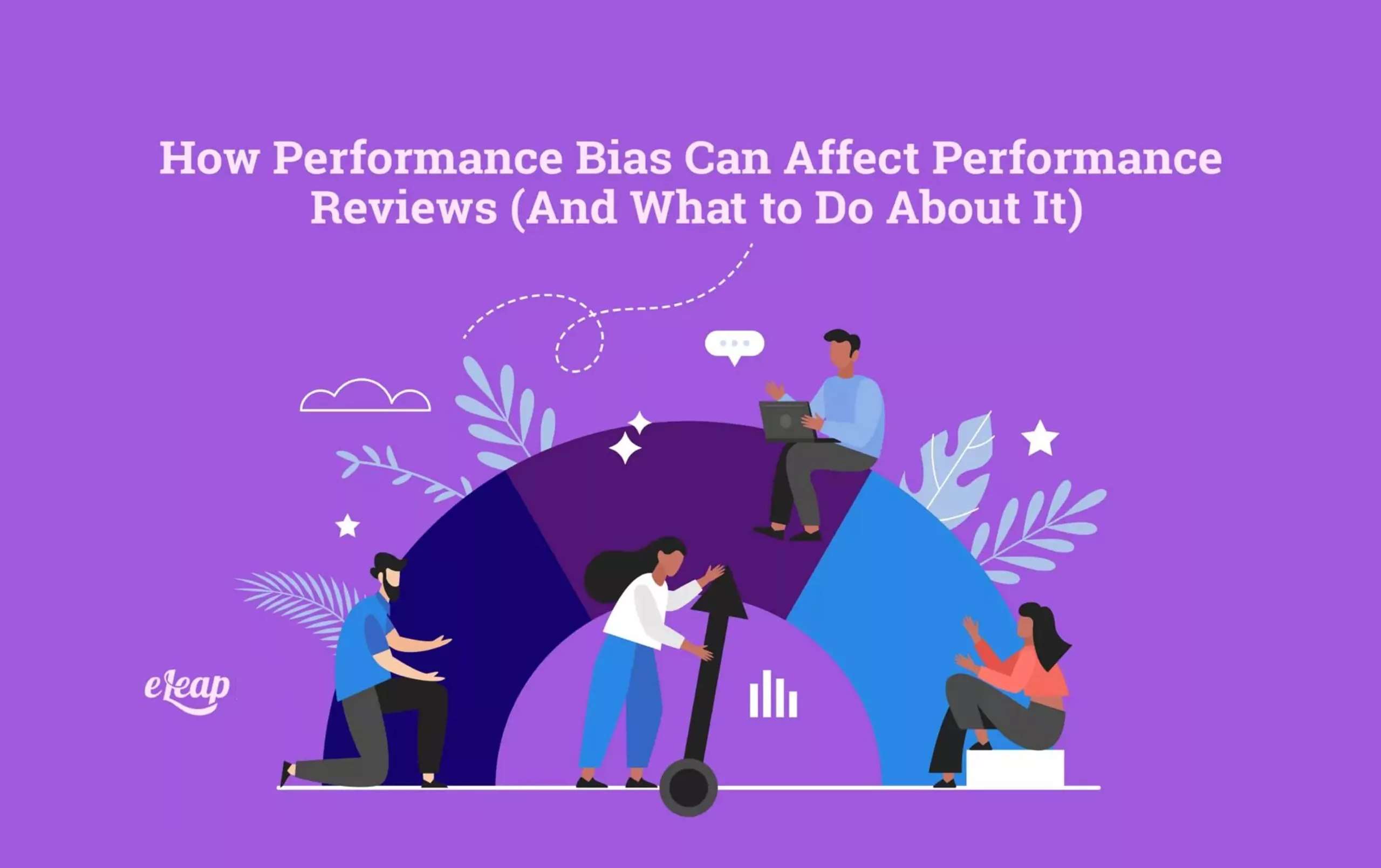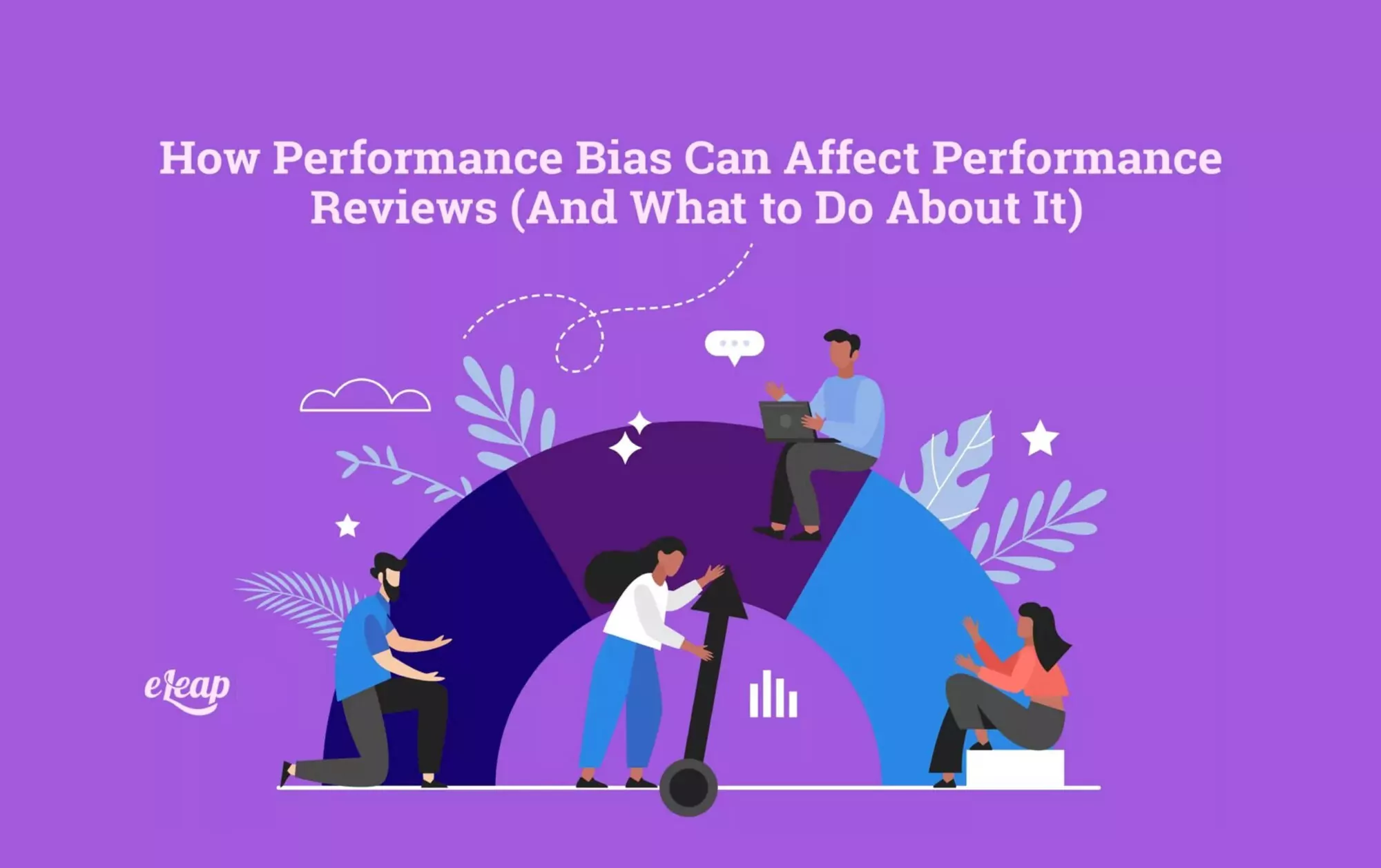How Performance Bias Can Affect Performance Reviews (And What to Do About It)

We all have conscious or unconscious biases, and performance bias from managers during reviews is no exception. A bias can be defined as a “prejudice in favor of, or against, someone or something.” Not all biases are negative – plenty of positive biases, too. For example, if you are an alumnus of the same university as your manager, they may have a positive bias toward you because they associate you with their school. Explore how eLeaP®’s Performance Management Platform can simplify evaluations, boost productivity, and drive measurable results.
Biases are ingrained in us at a young age by our parents, who, with no malicious intent, subject children to their prejudices. For example, one study found that when showing parents’ faces of gender-neutral infants, parents associated angry baby faces with boys and sad or happy baby faces with girls. Gender biases are one of the earliest developed, as girls are encouraged to go toward pink clothes and baby dolls, while boys are encouraged towards blue clothing and toy racecars.
Bias goes far beyond gender, however. Throughout our lives, we have experiences that shape our opinions of particular groups of people or characteristics. As a leader, it’s your responsibility to dismantle your biases and be very self-aware of your implicit opinions.
Different Categories of Performance Bias
Just like there are many ways certain biases develop, there are several different types of biases a manager can exhibit. If a manager can adequately identify their biases, targeting and questioning these implicit beliefs will be easier.
Recency Bias
Regency bias is common in a performance review setting, both among managers and employees. In most organizations, performance reviews occur every six months, but in some companies, they only happen every 12 months.
Due to this, managers and employees tend to focus on the most recent events of the past 1-3 months simply because they are fresh in the mind. During a self-review, an employee may exhibit recency bias by only noting recent events and accomplishments. Managers tend to do the same.
How to spot recency bias: If, in your review, your manager is only bringing up essential performance and metrics from the past 1-3 months, you can assume this is due to recency bias. Conversely, for managers, if an employee only notes recent achievements on a self-review, it’s likely the employee is exhibiting recency bias.
How recency bias can negatively affect your review: Your performance review may come when you are recovering from a particularly challenging few months at the company, even if the rest of the year has been great for you. If this is the case, recency bias can effectively negate all the great things you may have accomplished in the earlier portion of the timeframe.

How recency bias can positively affect your review: If the most recent months leading up to your review have been particularly productive or successful as an employee, it may negate struggles faced in the earlier portion of the year. Although this assessment is not fair, it can benefit the employee if it is their situation.
How to counter recency bias: It’s wise for employees to take note of every project, task, or achievement they receive during the year (or half year) leading up to the review. This way, when performance review season arrives, employees can take their notes and refresh themselves (and their managers) on the holistic view of their performance.
Whenever possible, managers should also note key achievements or struggles each of their employees faces throughout the year. This way, they can avoid subjecting themselves to implicit recency bias.
Contrast Bias
Contrast bias occurs when managers explicitly or implicitly compare performance between similar employees to rate their performance. This can be highly unfair, but it is a common bias.
How to spot contrast bias: If your manager pulls up your numbers in direct contrast with others in your department during your review, you can assume some contrast bias is at play. Similarly, if managers spend more time talking about others’ performance during your performance review, they are likely using your peers as a marker for your proficiency.
How contrast bias can negatively affect your review: Even if you are in the same role as the peers you are compared to, it’s not a fair way to measure performance by comparison.
For example, an employee who had a dip in performance may be dealing with particular circumstances that should be considered, such as illness or death in the family. Plus, when being rated against others, ancillary responsibilities and qualities that the employee offers can be swept under the rug in favor of comparison. With comparison bias, someone must always end up in the bottom ranks, even if they’ve done everything right on paper.
How contrast bias can positively affect your review: If you perform much better or more consistently than your peers, contrast bias can make an employee look much more efficient. This can vary greatly, but generally, someone who consistently outperforms their peers in almost every category will benefit from comparison bias.
How to counter contrast bias: If in your performance review, you notice your manager comparing you to others on the team, don’t be afraid to bring up extra job responsibilities you have voluntarily taken on, special projects only you have been working on, or any extenuating life circumstances that may make a comparison unfair. Soft skills, like timeliness and communication, should be brought up to differentiate yourself from your peers.
Managers should avoid comparing numbers whenever possible. They should look at an employee’s entire scope, from soft skills to new tasks taken on to any extenuating circumstances they know of in the employee’s life. The more managers can evaluate their employees as individual entities, the more accurate their reviews will be.
Horns Bias
Horn bias is particularly frustrating for most employees who have experienced it. This bias happens when a manager zeroes in on one negative quality or trait of an employee’s performance and lets it bleed into every review category.
How to spot a horns bias: If your manager starts your performance review by bringing up constructive criticism in a certain area or skillset and continually circles back to or relates that trait to other instances in your career, you can assume you are dealing with a horns bias. This bias can be hard to spot.
An excellent example of what a horns bias might sound like is to imagine an employee who has done a fantastic job overall but is very outspoken about a particular issue that has not been solved. If a manager disagrees with the employee’s outspoken nature, they may start with feedback that the employee needs to work on their communication skills or that they need to learn to control their emotions. Then, they may drag the employee’s perceived “communication issues” into other categories, even if they have no relation.
How a horns bias can negatively affect your review: This type of bias impacts every aspect of your review negatively. When managers focus too much on a specific trait about the employee they dislike, they will tie it into every category on the review, leaving the employee with a lower-than-deserved ranking.
How a horn bias can positively affect your review: There are virtually no upsides to a horn bias. There is a halo bias, which we will discuss later, which is the inverse of this bias.
How to counter a horns bias: By listening to their manager’s feedback, employees must first identify the exact behavior or event that triggered their manager’s negative view of them. Then, the employee should challenge what their review would sound like if they hadn’t taken that specific action. If the manager claims it wouldn’t make a difference, the employee can bring up big successes or achievements throughout the year and ask why the one specific adverse event or trait is tainting other positive contributions they have made.
In the end, this is a bias that the manager needs to work on. In many cases, no matter what argument or points an employee brings up about the unfairness of the horns bias, the manager must learn to control their perception and reactions to certain employees.
Halo Bias
This bias can be considered the exact opposite of the horns bias. This employee may do one thing or area of their job exceptionally well and, therefore, be rated highly in every performance category, even if they need improvement in some areas.
How to spot a halo bias: It can be hard to spot a halo bias because it’s a positive experience. You will likely get a glowing review focusing heavily on one or two big things you’ve achieved and how they helped the team. Areas for improvement will barely be touched on. An employee affected by a halo bias may ask for constructive criticism and not receive it.
How a halo bias can negatively affect your review: Although this kind of bias can feel positive for employees, it weakens their ability to improve. Without knowing your areas for improvement, you will have no idea how to improve and develop the following year.
How a horns bias can positively affect your review: You’ll likely get a very good review, even better than you should have gotten.
How to counter a halo bias: You don’t need to counter a halo bias. However, if you are consistently subjected to a halo bias for years, you may start to suffer in your development. If this is the case, employees can ask their manager to lay out a development plan based on their weak points.
Bottom Line
Performance bias appears in several ways in a manager/employee relationship. Biases are natural, ingrained from a young age, and therefore work their way into every social relationship, from family and friends to managing employees. However, managers can become aware of their own performance biases and begin to combat their thinking so they can provide the fairest and most productive review process for every employee.